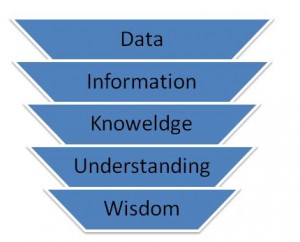These five terms form a hierarchy of value in which data have the least value and wisdom
has the most. I first ran across a similar description in the The Experience Economy an article published in 1998 by Joe Pine which I discussed in the blog post, Does your Value Proposition speak of the Customer Experience?. Though this chart has taken a fair amount of abuse over the years, I like it because it plainly depicts the hierarchy of what a customer is willing to pay for and therefore the customer’s perceived value.
In the book, Idealized Design the authors used a similar hierarchy for the key terms involved in describing organizational learning. They are as follows:
- Data consist of symbols that represent the properties of objects and events. They have little value until they have been processed into information Data are to information as iron or is to iron. Little can be done with iron ore until it is processed into iron.
- Information consists of data that has been processed to be useful. It is contained in descriptions, answers to question beginning with such words as what, who, when, when, and how many.
- Knowledge is contained in instructions, answers to how-to questions.
- Understanding is contained in explanations, answers to the why questions.
- Wisdom is concerned with the value of outcomes, effectiveness, whereas the other four types of mental content are concerned with efficiency. Efficiency is concerned with doing things right; effectiveness is concerned with doing the right thing.
Looks like a marketing funnel. Your budget probably looks the same way. You spend the vast majority of your marketing resources (time and money) on data or noise which may be the more appropriate term. I tend to believe a larger investment spent in understanding and wisdom will reap greater rewards.
It at first is counterintuitive. But when you think about it – an increase in knowledge, understanding about your customers and wisdom that your customers impart on you turns into:
- Upsells
- Referrals
- Word of mouth,
- PR Opportunities
- Innovation
 Just by the nature of the process, it should make you more effective and efficient. It goes back to the Pareto Principle or as Dr. Juran put it, “identify the vital few and the useful many,” in practice leave the top of the funnel (useful many) for automation, website sales, etc. Invest the majority of your resources (time and money) in the vital few. Work on delighting that segment of your business as Steven Deming, author of The Leader’s Guide to Radical Management
Just by the nature of the process, it should make you more effective and efficient. It goes back to the Pareto Principle or as Dr. Juran put it, “identify the vital few and the useful many,” in practice leave the top of the funnel (useful many) for automation, website sales, etc. Invest the majority of your resources (time and money) in the vital few. Work on delighting that segment of your business as Steven Deming, author of The Leader’s Guide to Radical Management writes Is Delighting your Customer Profitable?
One of the areas that we find out through better knowledge and understanding of our customers is the mistakes we are making as an organization. In the marketing sense, that blurriness of customer and marketing identification becomes much more apparent. The important critical to quality factors that are important to them and make them choose us drives our internal improvement efforts. Just as importantly, since we have a better relationship with the prospects/customers at the bottom of the funnel, we find out what mistakes and why others were chosen. This will help us tremendously to evaluate our shortcomings and improve on them.
Choosing this perspective will probably reduce the size of the opening of your funnel. However which end of the funnel is important to you?

